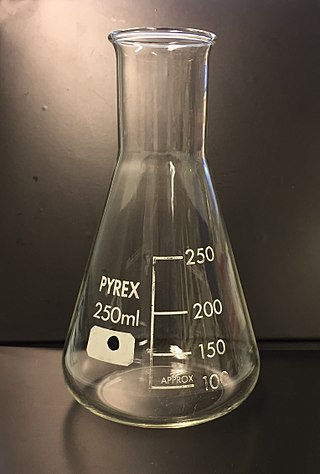
An Erlenmeyer flask, also known as a conical flask or a titration flask, is a type of laboratory flask which features a flat bottom, a conical body, and a cylindrical neck. It is most often used in a laboratory. It is named after the German chemist Emil Erlenmeyer (1825–1909), who created it in 1860.

Laboratory glassware refers to a variety of equipment used in scientific work, and traditionally made of glass. Glass can be blown, bent, cut, molded, and formed into many sizes and shapes, and is therefore common in chemistry, biology, and analytical laboratories. Many laboratories have training programs to demonstrate how glassware is used and to alert first–time users to the safety hazards involved with using glassware.

A Florence flask/boiling flask is a type of flask used as an item of laboratory glassware and is named after the city Florence. It is used as a container to hold liquids. A Florence flask has a round body, a long neck, and often a flat bottom. It is designed for uniform heating, boiling, distillation and ease of swirling; it is produced in a number of different glass thicknesses to stand different types of use. They are often made of borosilicate glass for heat and chemical resistance. Traditional Florence flasks typically do not have a ground glass joint on their rather longer necks, but typically have a slight lip or flange around the tip of the neck. The common volume for a Florence flask is 1 litre.

A vacuum flask is an insulating storage vessel that greatly lengthens the time over which its contents remain hotter or cooler than the flask's surroundings. Invented by Sir James Dewar in 1892, the vacuum flask consists of two flasks, placed one within the other and joined at the neck. The gap between the two flasks is partially evacuated of air, creating a near-vacuum which significantly reduces heat transfer by conduction or convection. When used to hold cold liquids, this also virtually eliminates condensation on the outside of the flask.

A stopper is a cylindrical or conical closure used to seal a container, such as a bottle, tube or barrel. Unlike a lid or bottle cap, which encloses a container from the outside without displacing the inner volume, a bung is partially or wholly inserted inside the container to act as a seal. Synonyms are bung and cork. A bung can be defined as "a plug or closure used to close an opening in a drum or barrel. It is called a plug when referring to a steel drum closure."

Pozzuoli is a city and comune of the Metropolitan City of Naples, in the Italian region of Campania. It is the main city of the Phlegrean Peninsula.

Baiae was an ancient Roman town situated on the northwest shore of the Gulf of Naples and now in the comune of Bacoli. It was a fashionable resort for centuries in antiquity, particularly towards the end of the Roman Republic, when it was reckoned as superior to Capri, Pompeii, and Herculaneum by wealthy Romans, who built villas here from 100 BC. Ancient authors attest that many emperors built in Baia, almost in competition with their predecessors and they and their courts often stayed there. It was notorious for its hedonistic offerings and the attendant rumours of corruption and scandal.

A volumetric flask is a piece of laboratory apparatus, a type of laboratory flask, calibrated to contain a precise volume at a certain temperature. Volumetric flasks are used for precise dilutions and preparation of standard solutions. These flasks are usually pear-shaped, with a flat bottom, and made of glass or plastic. The flask's mouth is either furnished with a plastic snap/screw cap or fitted with a joint to accommodate a PTFE or glass stopper. The neck of volumetric flasks is elongated and narrow with an etched ring graduation marking. The marking indicates the volume of liquid contained when filled up to that point. The marking is typically calibrated "to contain" at 20 °C and indicated correspondingly on a label. The flask's label also indicates the nominal volume, tolerance, precision class, relevant manufacturing standard and the manufacturer's logo. Volumetric flasks are of various sizes, containing from a fraction of a milliliter to hundreds of liters of liquid.

A Büchner funnel is a piece of laboratory equipment used in filtration. It is traditionally made of porcelain, but glass and plastic funnels are also available. On top of the funnel-shaped part there is a cylinder with a fritted glass disc/perforated plate separating it from the funnel. The Hirsch funnel has a similar design; it is used similarly, but for smaller quantities of material. The main difference is that the plate of a Hirsch funnel is much smaller, and the walls of the funnel angle outward instead of being vertical.
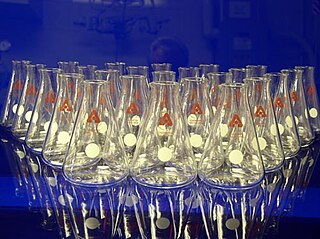
Laboratory flasks are vessels or containers that fall into the category of laboratory equipment known as glassware. In laboratory and other scientific settings, they are usually referred to simply as flasks. Flasks come in a number of shapes and a wide range of sizes, but a common distinguishing aspect in their shapes is a wider vessel "body" and one narrower tubular sections at the top called necks which have an opening at the top. Laboratory flask sizes are specified by the volume they can hold, typically in metric units such as milliliters or liters. Laboratory flasks have traditionally been made of glass, but can also be made of plastic.

Via Domiziana is the modern name for the Via Domitiana in the Campania region of Italy, a major Roman road built in 95 AD under the emperor, Domitian, to facilitate access to and from the important ports of Puteoli and Portus Julius in the Gulf of Naples.

Round-bottom flasks are types of flasks having spherical bottoms used as laboratory glassware, mostly for chemical or biochemical work. They are typically made of glass for chemical inertness; and in modern days, they are usually made of heat-resistant borosilicate glass. There is at least one tubular section known as the neck with an opening at the tip. Two- or three-necked flasks are common as well. Round bottom flasks come in many sizes, from 5 mL to 20 L, with the sizes usually inscribed on the glass. In pilot plants even larger flasks are encountered.

The Mattiaci were by Tacitus recorded as an ancient Germanic tribe and related to the Chatti, their Germanic neighbors to the east. There is no clear definition of what the tribe's name meant. The Dictionary of Greek and Roman Geography suggests that the name is derived from a combination of 'matte', meaning 'a meadow', and 'ach', signifying water or a bath.
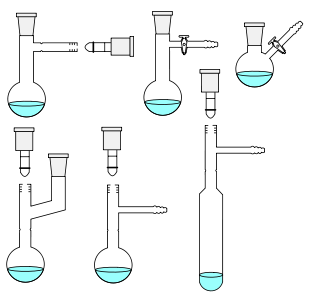
A Schlenk flask, or Schlenk tube, is a reaction vessel typically used in air-sensitive chemistry, invented by Wilhelm Schlenk. It has a side arm fitted with a PTFE or ground glass stopcock, which allows the vessel to be evacuated or filled with gases. These flasks are often connected to Schlenk lines, which allow both operations to be done easily.

The Piscina Mirabilis is an Ancient Roman cistern on the Bacoli hill at the western end of the Gulf of Naples, southern Italy. It ranks as one of the largest ancient cisterns built by the ancient Romans, compared to the largest Roman reservoir, the Yerebatan Sarayi in Istanbul.
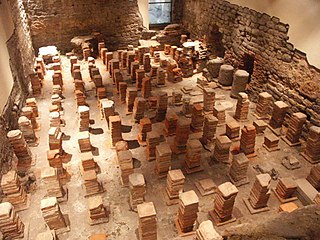
Pilae stacks are stacks of pilae tiles, square or round tiles, that were used in Roman times as an element of the underfloor heating system, common in Roman bathhouses, called the hypocaust. The concept of the pilae stacks is that the floor is constructed at an elevated position, allowing air to freely circulate underneath and up, through the hollow bricks, into the structure walls. Examples of such baths are found not only in Rome, but also in distant parts of the Roman Empire such as Roman Britain, or Chellah, in modern-day Morocco.
Miseno is one of the frazioni of the municipality of Bacoli in the Italian Province of Naples. Known in ancient Roman times as Misenum, it is the site of a great Roman port.
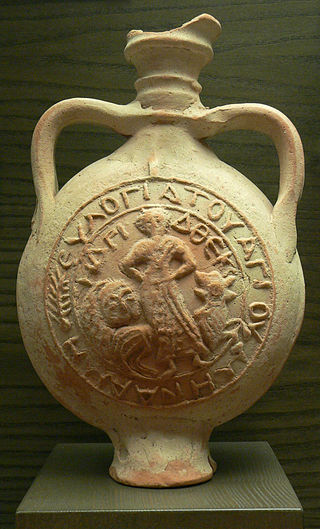
An ampulla was, in Ancient Rome, a small round vessel, usually made of glass and with two handles, used for sacred purposes. The word is used of these in archaeology, and of later flasks, often handle-less and much flatter, for holy water or holy oil in the Middle Ages, often bought as souvenirs of pilgrimages, such as the metal Monza ampullae of the 6th century. Materials include glass, ceramics and metal. Unguentarium is a term for a bottle believed to have been used to store perfume, and there is considerable overlap between the two terms, one defined by shape and the other by purpose.

Ancient Campania originally indicated the territory of the ancient city of Capua in the Roman period, and later also the plains of the various neighbouring municipalities. It was a very large territory when compared with the other Italic cities of the Roman and pre-Roman period.



















